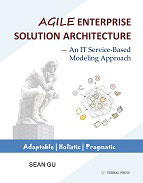
 |
AGILE Enterprise Solution Architecture: An IT Service-Based Modeling Approach
by Sean Gu
Vernal Press
IT is one of those disciplines that must constantly change and adapt to the newest business communication needs and technology. As explained by the author, the AGILE ESA model makes it easier for IT groups—from install technicians to service managers—to work together on a massive project. The "Architecture Overview" capability provides tier views, layer views, and sketch views that quickly bring all concerned parties into the plan. AGILE team members can also be involved in solution architecture governance. Of course, security plans for possible risk and future recovery solutions are considered. An architectural checklist finishes the main section.
The case study included serves as a good example of how to use the ESA model to accomplish a three-year road map to accomplish the following steps: (1) update various older technologies; (2) move from a traditional to more focused view; (3) build a web-based solution in order to go mobile. Chapter 4 is the perfect point to introduce this case study if the book is to be used as a teaching tool for IT people.
The author writes authoritatively and has made a reputation for himself in the IT industry over the past twenty-five years. He led many large-scale projects in the United States and China, and as an instructor, he has mentored top-level IT executive architects. Experienced IT engineers and technicians will likely appreciate and recognize Table 6 as a smorgasbord of model elements classified as basic, core, or system. One can easily pick and choose from this list of elements to create a system that supports the end goals of a business. Six appendices also provide readers with handy references for filling out their own ESA model.